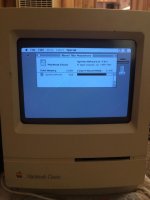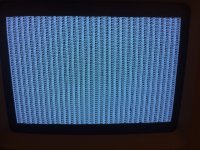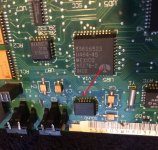I recently acquired a Classic, which boot and ran when arrived, although the sound didn't work. Cracked the case and was pleased that someone had removed the battery long ago and there was zero battery damage, but I noticed that there was some slight cap leakage around C8 and C9, although it was very slight. I removed all the old caps, gave the board a good thorough washing, and recapped with tantalum caps. However, owing to it being my first experience with tantalum caps, I had assumed the stripe was negative, since every other kind of polarized cap I've dealt with stripes the negative end. The result was I soldered them all on backwards. Didn't realize it until I powered the machine up and C8 exploded. Removed all those caps and threw them away. Thankfully I had bought a bunch of them to have on hand. Put new one's in oriented correctly, and powered up the machine to a checkerboard screen.
Brought out the multimeter and checked traces around the caps for damage and continuity. They all checked out okay. Checked the voltage; 5.03 and 12.09, so that's right where it needs to be.
Started probing signals at various points on the board just to see what was working and what wasn't. And I discovered that the CPU reset line is being held low (it's low enabled), so the CPU is stuck in a reset loop. To test a theory, I jumpered 5v to the CPU reset pin, and it booted up to the flashing disk icon (I did this test with all the drives disconnected). It also gave me the startup bong, which it hadn't done before I recapped, so yay for working sound. But, when I remove the jumper wire the display freezes until power is cycled and it goes back to checkerboard.
So I traced the reset line for continuity. It checks out. Then I poked around the reset button circuit. All the traces and components check out. The reset button circuit is connected to a pin on the sound IC (UA5), which is next to the pin the CPU reset line connects. I don't know pin numbers, and have been unable to find a datasheet on that chip. But if you're standing the board up so the writing is horizontal, it's on the bottom of the chip on the right hand side. Checking the voltage at that point reads 5v with the reset button unpressed, which is what I expected. But pressing the reset button drops that to 3.48v, not the logic low that I expected. Pressed or unpressed, the CPU reset line stays at ground.
So, I'm hoping this is a situation others have experienced before. My theories so far are:
Theory 1: I damaged the sound IC when I put the caps on backwards. Though, if I have damaged it, the fact that I got sound when I jumpered the reset line seems more puzzling. But, it's possible I suppose that somehow the CPU reset line is shorted to ground internal to the chip. Though, it still remains a puzzle why pressing the reset button only drops from 5v to 3.48 at the sound IC.
Theory 2: The reset line is shorted to ground internal to one of the other ICs that it connects to (it connects to half the ICs on the board).
Theory 3: The CPU reset line is shorted to ground at a trace or via, and after hours of searching I still haven't been able to spot it.
Theory 4: Ground isn't ground on the logic board. For ease, when probing I was using the hard drive power connector ground under the assumption that it would be the same ground as the logic board.
Anywhere else I can check? Worst case scenario I can just permanently jumper the CPU reset line to 5v. But, that means I can only restart the computer by power cycling, and although that's not a huge deal, if I can fix it so that it's working properly that is the ideal scenario.
Brought out the multimeter and checked traces around the caps for damage and continuity. They all checked out okay. Checked the voltage; 5.03 and 12.09, so that's right where it needs to be.
Started probing signals at various points on the board just to see what was working and what wasn't. And I discovered that the CPU reset line is being held low (it's low enabled), so the CPU is stuck in a reset loop. To test a theory, I jumpered 5v to the CPU reset pin, and it booted up to the flashing disk icon (I did this test with all the drives disconnected). It also gave me the startup bong, which it hadn't done before I recapped, so yay for working sound. But, when I remove the jumper wire the display freezes until power is cycled and it goes back to checkerboard.
So I traced the reset line for continuity. It checks out. Then I poked around the reset button circuit. All the traces and components check out. The reset button circuit is connected to a pin on the sound IC (UA5), which is next to the pin the CPU reset line connects. I don't know pin numbers, and have been unable to find a datasheet on that chip. But if you're standing the board up so the writing is horizontal, it's on the bottom of the chip on the right hand side. Checking the voltage at that point reads 5v with the reset button unpressed, which is what I expected. But pressing the reset button drops that to 3.48v, not the logic low that I expected. Pressed or unpressed, the CPU reset line stays at ground.
So, I'm hoping this is a situation others have experienced before. My theories so far are:
Theory 1: I damaged the sound IC when I put the caps on backwards. Though, if I have damaged it, the fact that I got sound when I jumpered the reset line seems more puzzling. But, it's possible I suppose that somehow the CPU reset line is shorted to ground internal to the chip. Though, it still remains a puzzle why pressing the reset button only drops from 5v to 3.48 at the sound IC.
Theory 2: The reset line is shorted to ground internal to one of the other ICs that it connects to (it connects to half the ICs on the board).
Theory 3: The CPU reset line is shorted to ground at a trace or via, and after hours of searching I still haven't been able to spot it.
Theory 4: Ground isn't ground on the logic board. For ease, when probing I was using the hard drive power connector ground under the assumption that it would be the same ground as the logic board.
Anywhere else I can check? Worst case scenario I can just permanently jumper the CPU reset line to 5v. But, that means I can only restart the computer by power cycling, and although that's not a huge deal, if I can fix it so that it's working properly that is the ideal scenario.



